Before defining the sphere of activity of UFO-SCIENCE, here is the summary about scientific research carried out in France for sixty years on the UFO case, and in particular since the official study undertaken in 1977, just thirty years ago.
RADIAL STREAMLINE AIRFLOW: COANDA EFFECT DISKS
In the 1930’s the Rumanian scientist Henri Coanda invented discoidal machines1 using a fluid dynamics principle which now bears his name: the Coanda effect.

You can read a popularized explanation of this effect applied to his flying discs in the document available at the Downloads section: “Flying saucers R&D – The Coanda effect“. In his lab, Coanda made models of these devices fly, and during all the experiment they were trailing behind them the tube which brought the air under high pressure required for their operation. No embedded engine compressor is indeed both light and powerful enough to generate an airflow along the curved fuselage, thanks to the Coanda effect, fast enough to suck the ambient air and to make such an aircraft autonomously lift.
ELECTROMAGNETIC PROPULSION : MHD AERODYNES
However, a new kind of propulsion involving magnetohydrodynamics (MHD) exists. MHD propulsion allows to accelerate an electrically conductor fluid (liquid or ionized gas called “plasma”) to thousands miles per hour thanks to electromagnetic forces, without any moving part.

Plasma MHD propulsion devices (sometimes rather called MPD drives for “magnetoplasmadynamics”) are known since 1950’s. But in 1975, the physicist Jean-Pierre Petit conceptualized a new kind of MHD propulsor, where the accelerated gas does not run out inside a nozzle anymore, but goes around the whole external hull of a disc-shaped aircraft (MHD converter with external flow). It is no more than a Coanda disc, where the effect is generated in a ionized gas by electromagnetic forces. The plasma is not formed from an onboard propellant, but directly by the ionized ambient air. Dr Petit calls these new MHD accelerators with external ionized airflow: MHD aerodynes.

You can familiarize yourself with magnetohydrodynamics and these MHD aerodynes thanks to the popularized science comics (freely downloadable): “The Silence Barrier“.
Les dispositifs de propulsion MHD à plasma sont connus depuis les années 1950. Mais le physicien Jean-Pierre Petit a conceptualisé à partir de 1975 des accélérateurs MHD d’un genre nouveau, où le gaz accéléré ne s’écoule plus à l’intérieur d’une tuyère, mais tout autour de la paroi extérieure de l’engin.
Ce sont donc des “accélérateurs MHD à écoulement externe” constituant des disques de Coanda dont l’effet est généré par des forces électromagnétiques. Le plasma est de plus formé non pas à partir d’un ergol embarqué, mais en ionisant directement l’air ambiant.
JP Petit nomma ce concept d’accélérateur MHD à écoulement gazeux externe et à contrôle d’ionisation un aérodyne MHD.
SUPERSONIC FLIGHT WITHOUT SHOCK WAVE BY MHD FORCE FIELD
These MHD aerodynes are perfectly similar to the UFOs being observed in the world since sixty years, from the strange shapes to the luminous and electromagnetic effects on their environment noted in various testimonies. With the adequate power source, these MHD aircrafts could cruise at supersonic speed in dense air, without making any noise : contrary to the popular idea, the silence of UFOs can be explained, and this field leads to very innovative studies.
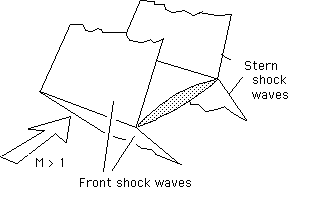 For example, MHD hydaulics experiments has been carried out, magnetized plasma were modeled with high-voltage and high frequencies in low pressure air, 1D and 2D theoretical simulations has been computed… this research demonstates the possibility for an MHD aerodyne to cruise at supersonic and hypersonic speed, noiseless. It lead to several discoveries exposed in international MHD meetings and publications in specialized reviews (you can read here the list of these papers).
For example, MHD hydaulics experiments has been carried out, magnetized plasma were modeled with high-voltage and high frequencies in low pressure air, 1D and 2D theoretical simulations has been computed… this research demonstates the possibility for an MHD aerodyne to cruise at supersonic and hypersonic speed, noiseless. It lead to several discoveries exposed in international MHD meetings and publications in specialized reviews (you can read here the list of these papers).
Such a technological progress would actually be a very important leap: a supersonic aircraft moving at Mach 2.0 consumes more than 20 % of its energy to generate and overcome shock waves and slipstream, which not only slow down the vehicle, but also quickly heat the materials cause of the brutal gas recompression behind the bow shock wave. This is the “heat barrier” which prohibits making hypersonic aircrafts today.
But a special aircraft, controlling airflow at any point of its hull thanks to ambiant electomagnetic forces, would cancel drag, slipstream and dramatically reduce wall heating. It would make possible quiet flight at hypersonic speed, without sound nor heat barriers even at low altitude, in dense air (speeds in excess of Mach 12 or 15 possible). Such a device would obviously attract the army since it represents, in a military mind, the perfect cruise missile: extremely fast while being completely furtive thanks to a low altitude evolution, under the radar coverage. Interest from the army into such a possible next generation nuclear weapons delivery system, coupled wih the obvious link with UFOs, perhaps explains the many difficulties encountered to freely study this subject within public governmental laboratories.


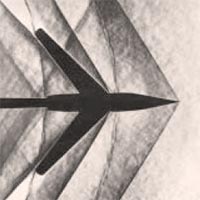
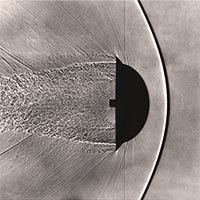
Shock wave patterns and turbulent wakes around various profiles
- Hydraulic Analogy :
 Before the advent of computers, students in aeronautical schools made supersonic flow simulations inside “hydraulic analogy tanks” where the classical air flow around a model was replaced by a slower and denser water flow. Fluid dynamics has indeed the same set of equations, whether in gas or in water. The analogy is complete because the bow and stern waves on the liquid surface, around a boat, are faithful analogues of wavefronts around an aircraft moving at supersonic speed in air, just as the turbulent slipstream.
Before the advent of computers, students in aeronautical schools made supersonic flow simulations inside “hydraulic analogy tanks” where the classical air flow around a model was replaced by a slower and denser water flow. Fluid dynamics has indeed the same set of equations, whether in gas or in water. The analogy is complete because the bow and stern waves on the liquid surface, around a boat, are faithful analogues of wavefronts around an aircraft moving at supersonic speed in air, just as the turbulent slipstream.
In 1976, Dr. Jean-Pierre Petit and his colleague Maurice Viton made an MHD experiment in liquid medium: a cylindrical profile with two electrodes, plunged into an acidulous water flow, electrically conductive. The flow speed of water simulates a supersonic flight. At first, a water pad appears in front of the model, and oblique bow waves form around the profile, while slipstream becomes strongly turbulent.
Then the MHD system is switched on. A magnetic field (1 Tesla) generated by an electromagnet surrounds the model, while a generator outputs an electrical current in water, through each electrode on the cylinder. This establishes a strong Lorentz force field all around the model, acting on the flow. The entire system becomes an MHD accelerator with external liquid flow: an MHD hydrodyne.

 Surprise: as soon as the MHD system is activated, turbulent slipstream disappears. The flow behind the cylinder becomes laminar again, as if it was at a subsonic speed. When the power increases, even the bow shock wave disappears too! More than that, the water surface in the front area of the cylinder grows hollow: not only the shock wave is annihilated, but the hydrodyne sucks water in front of it before molecules can pile up at the stagnation point. The whole system is then tractor, with a negative drag.
Surprise: as soon as the MHD system is activated, turbulent slipstream disappears. The flow behind the cylinder becomes laminar again, as if it was at a subsonic speed. When the power increases, even the bow shock wave disappears too! More than that, the water surface in the front area of the cylinder grows hollow: not only the shock wave is annihilated, but the hydrodyne sucks water in front of it before molecules can pile up at the stagnation point. The whole system is then tractor, with a negative drag.
These positive results lead to communications in 1983 at the international MHD meeting in Moscow, and a 16mm footage were even filmed. This experiment has been successfully reproduced elsewhere, first by a team of the aeronautical school ENSAE (monitored by the CNES) in 1981, and at the engineering school ENSEEIHT in 1983 (documents available at the Downloads section).
.
- Mathematical calculations :
Hydraulics is only the first step towards the complete shock wave elimination arround a body embedded in a supersonic airflow, thanks to MHD action.
The next step, after these hydraulic analogy experiments, is to mathematically model the complete control of a supersonic gas flow around a wing profile by Lorentz forces, making wavefronts disappear.
This work has been done. In 1987, Bertrand Lebrun, ENSAM engineer, accomplishes its doctorate thesis under the direction of Pr. Jean-Pierre Petit. He obtains a DEA (French postgraduate degree) in the field of fluid mechanics, then develops a new method solving the Navier-Stokes equations (the laws describing the motion of fluids substances such as liquids and gases) in the presence of a MHD force field, thanks to the method of characteristics. This work succeeds and is published in 1986 at the 9th International MHD Meeting in Tsukuba, Japan, and at the following international conference held in 1992 in Beijing, China. This thesis work is also published in the European Journal of Mechanics (then in the former French version “Journal de Mécanique”) in 1989.
- Wind tunnel experiments :
Still, it would have been logical to follow this idea to the end, and make a true experiment of flow control annihilating the shock waves by MHD, around a test model embedded in a subsonic then hypersonic gas flows, inside a wind tunnel… But this experiment has never been done!
Precise recommendations of experimental modelings were proposed several times to the GEPAN scientific council (CNES service), in vain. In 1980, Dr. Jean-Pierre Petit gives to CNES a 200-pages report entitled “Perspectives in magnetohydrodynamics” containing a mass of rough, directly exploitable ideas to undertake multiple experiments. Then someone finally decided to make an ambitious MHD experiment dealing with air ionized by a powerful pulsed microwave source.
![]() But the research managers leading this study were arbitrarily and politically chosen, and Dr. Jean-Pierre Petit was deliberately isolated although he was the father of these ideas. More than that, one of the manager was an optical technician and the other was a specialist in traditional fluid dynamics. So none had the required know-how about cold plasma physics dealing with strong magnetic fields, a science full of unforeseeable difficulties. And as envisaged by Jean-Pierre Petit if done like that, the experiment tried in 1983 inside a scientific center near the city of Toulouse, France, was a complete failure.
But the research managers leading this study were arbitrarily and politically chosen, and Dr. Jean-Pierre Petit was deliberately isolated although he was the father of these ideas. More than that, one of the manager was an optical technician and the other was a specialist in traditional fluid dynamics. So none had the required know-how about cold plasma physics dealing with strong magnetic fields, a science full of unforeseeable difficulties. And as envisaged by Jean-Pierre Petit if done like that, the experiment tried in 1983 inside a scientific center near the city of Toulouse, France, was a complete failure.
And the details about this failure were published in a special issue of a French review publicly available in kiosk, which devoted all its pages to the case and a cover saying: “GEPAN: one too many experiment”. The GEPAN scientific council was immediately dissolved.
Since this era, research in the field of MHD propulsion in cold plasmas, which are “two-temperatures” gas (nonequilibrium plasma where electrons are much hotter than ions) has been stopped. The know-how has even been lost, in most countries.
The accumulated delay in front of USA or Russia is very important, because they do not have ever ceased this research, as opposed to what other nations believed for a long time. A national “technological pole on cold plasmas” has just been created in France in order to give the country the desired competences applied to the aerospace field again, as in the 1970’s. But in spite of funds allocated to various laboratories, the studies are of the same quality than those practised at the end of the 1960’s (shock wave upon a plasma generated by high voltage ahead of a conical shape inside a wind tunnel). There is none magnetic field in these static plasmas, so no Lorentz forces to locally accelerate or slow down the flow, i.e. make a true flow control around a body. For now the scientists try to understand again the “plasma/schock wave interaction” which is only the premises of magnetohydrodynamics in supersonic cold plasmas (active flow control), field much more complex…
Fortunately the UFO-SCIENCE team is directed by former researchers now retired. They did worked a long time ago in the field of nonequilibrium plasmas under high magnetic fields, MHD-gas experiments. Although “put in the garbage” by the French national research department, their knowledge and their creativity are intact!
ELECTROHYDRODYNAMICS (EHD)
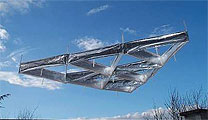 Beside MHD, another technology has recently been spoted out : electrohydrodynamics (EHD) popularized by “lifters”. It is a pure electric propulsion (no magnetic field) in the past called “ionic wind”, which accelerates ions through a very high voltage electric field. This creates electrostatic forces (paraelectric, peristaltic…) in the air which make it flow along a privileged direction. There is no electromagnet inside an EHD device, thus it is lighter than any MHD device. But the performance per weight ratio of an EHD device is good much because the device mass is as low as the total electric power (lifters are made from balsa wood and kitchen aluminium foils, the power supply is external and outputs only a few watts of power, if not an electric breakdown spark and an arc short-circuit occur).
Beside MHD, another technology has recently been spoted out : electrohydrodynamics (EHD) popularized by “lifters”. It is a pure electric propulsion (no magnetic field) in the past called “ionic wind”, which accelerates ions through a very high voltage electric field. This creates electrostatic forces (paraelectric, peristaltic…) in the air which make it flow along a privileged direction. There is no electromagnet inside an EHD device, thus it is lighter than any MHD device. But the performance per weight ratio of an EHD device is good much because the device mass is as low as the total electric power (lifters are made from balsa wood and kitchen aluminium foils, the power supply is external and outputs only a few watts of power, if not an electric breakdown spark and an arc short-circuit occur).
 Better EHD devices are studied in lab since a decade, with glow discharge plasmas. Some new systems can ionize air at standard atmopsheric pressure (such as OAUGDP panels, for One Atmosphere Uniform Glow Discharge Plasma). Acceleration of ionized gas reaches now several hundreds feet per second. The EHD propulsion accelerating a plasma inside a peristaltic varying electric field allows a theoretical maximum air speed of about a thousand feet per second (when viscosity is neglected) in a layer a few millimeters thick, thus approaching the speed of sound. These devices can modify the boundary layer flow and are mainly considered to be used on wings surface in order to increase lift under strong angle of attack, or to replace mobile flaps (plasma actuators). The plasma actuators have been successfully used in different flow control applications, such as exciting boundary layer instabilities on a sharp cone at Mach 3.5, lift augmentation on a wing section, low-pressure turbine blade separation control, turbine tip clearance flow control, bluff body control, drag reduction, unsteady vortex generation, and airfoil leading-edge separation control. But contrary to magnetohydrodynamics which implies higher power (several megawatts) and can move gas to several miles per second acting on both boundary and shock layers of the flow, electrohydrodynamics is however intrinsically unable to act sufficiently on the shock layer to eliminate the sonic boom at supersonic speed.
Better EHD devices are studied in lab since a decade, with glow discharge plasmas. Some new systems can ionize air at standard atmopsheric pressure (such as OAUGDP panels, for One Atmosphere Uniform Glow Discharge Plasma). Acceleration of ionized gas reaches now several hundreds feet per second. The EHD propulsion accelerating a plasma inside a peristaltic varying electric field allows a theoretical maximum air speed of about a thousand feet per second (when viscosity is neglected) in a layer a few millimeters thick, thus approaching the speed of sound. These devices can modify the boundary layer flow and are mainly considered to be used on wings surface in order to increase lift under strong angle of attack, or to replace mobile flaps (plasma actuators). The plasma actuators have been successfully used in different flow control applications, such as exciting boundary layer instabilities on a sharp cone at Mach 3.5, lift augmentation on a wing section, low-pressure turbine blade separation control, turbine tip clearance flow control, bluff body control, drag reduction, unsteady vortex generation, and airfoil leading-edge separation control. But contrary to magnetohydrodynamics which implies higher power (several megawatts) and can move gas to several miles per second acting on both boundary and shock layers of the flow, electrohydrodynamics is however intrinsically unable to act sufficiently on the shock layer to eliminate the sonic boom at supersonic speed.
OPTICAL DIFFRACTION GRATING CAMERA CAPS
An another topic, “diffracting camera caps” were distributed to the French national military police squads “Gendarmerie” in the 1980’s. Made of an optical diffraction grating pattern conceived by Jobin & Yvon company, they can be fixed in front of the camera’s objective glass to print on the film the spectral lines of any luminous object, transforming the camera into a true spectroscope.
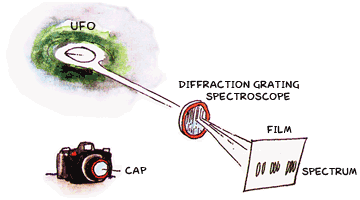 The French Gendarmes had the role of using them each time they would observe unidentified luminous phenomena at night. These diffracting caps were made in order to know more about UFOs, because the luminous spectrum of an object gives information on its chemical composition, its temperature, if it emits characteristic radiations such as infrareds or ultraviolet rays, if it generates a magnetic field, high-frequencies, etc. After thirty years, what are the results, according to consultants of the laboratory charged to analyze these spectra? Two pictures, and none is exploitable! Besides these caps are lost since a score of years at the bottom of forgotten drawers. Now people have a lot of digital cameras even in their mobile phone, so it would be interesting to equip the general public with these cheap diffracting caps.
The French Gendarmes had the role of using them each time they would observe unidentified luminous phenomena at night. These diffracting caps were made in order to know more about UFOs, because the luminous spectrum of an object gives information on its chemical composition, its temperature, if it emits characteristic radiations such as infrareds or ultraviolet rays, if it generates a magnetic field, high-frequencies, etc. After thirty years, what are the results, according to consultants of the laboratory charged to analyze these spectra? Two pictures, and none is exploitable! Besides these caps are lost since a score of years at the bottom of forgotten drawers. Now people have a lot of digital cameras even in their mobile phone, so it would be interesting to equip the general public with these cheap diffracting caps.
All these alleged official studies wasting public monies without any result must be stopped and replaced by another functional approach. It is not even the problem “to convince the authorities” any more. Simply a real serious and profitable scientific study can and will now be undertaken.
1 Henri Coanda (7 juin 1886 – 25 novembre 1972 à Bucarest) est un ingénieur aéronautique roumain displômé de SUPAERO (École nationale supérieure de l’aéronautique et de l’espace). Pionnier du moteur à réaction, il présenta le premier avion à réaction au salon de Paris en 1910. Il est l’auteur de divers brevets, dont celui portant sur l’effet Coanda en 1934, et sur son application à la propulsion de disques volants dès 1935.
